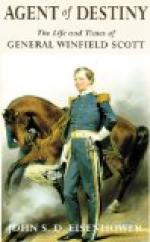Scott’s action in the
cholera epidemic, 55-57; commissioner to treat with Indians; result
of the treaty, 58; arrives in New York, and ordered to Washington;
the tariff act of 1828 and excitement in South Carolina, 60; ordered
to South Carolina, 66; letter of instruction from Secretary of War;
arrival in Charleston, 66, 67; detained by accident, 68; success of
his mission, 71; ordered to immediate command in Florida, 98;
disposition of troops, 110-112; movement of troops, 114; the army
arrives at Tampa Bay, 117; arrival at Fort Brooke, 118; embarks on
St. John’s River, 120; complaint against General Jesup; court of
inquiry on Florida campaign, 122; finding of the court; letter to
Secretary of War, 123; defense in Congress, 124; tendered dinner in
New York; declines, 127; ordered to remove the Creek Indians, 129;
addresses to troops and Indians, 130, 132, 133; the Indians move
West, 135; ordered to look after Canada insurgents, 139; ordered to
Maine, 140; meets Governor Everett; proceeds to Portland, 141;
settlement of the troubles, 143, 144; uprising in Upper Canada;
affair of the Caroline, 144, 145; ordered to the scene of the
troubles; meets Governor Marcy, 146; letter to commanding officer of
British vessels, 147; the affair settled, 147, 148; his name
presented to Whig Convention as candidate for the presidency, 152;
effort in Congress to reduce his pay; letter to T.P. Atkinson on
slavery, 153; letter to peace convention, 154; the War with Mexico;
the “hasty plate of soup,” 157; his opinion of General Taylor;
ordered to Mexico; goes via New Orleans, 158; arrives at Brazos
Santiago, 159; fails to meet General Taylor, 161; landing of the
troops at Vera Cruz, 162; investment and surrender of Vera Cruz,
164-170; advances on Jalapa, 173; Cerro Gordo, 178, 179, 187;
occupation of Puebla, 193; movement toward the City of Mexico;
criticism by the Duke of Wellington, 195, 196; address to Mexican
people, 198; movement on and capture of Padierna, 204-207;
Churubusco, 211; arrival of Nicholas P. Trist, U.S. Commissioner,
213; cessation of hostilities by armistice, 214; the armistice
ended, 218; Molino del Rey, 219-222; attack on and capture of
Chapultepec, 226, 227; occupation of the capital; orders for
government of the city, 229; additional orders, 231-234; orders for
obtaining revenue in Mexico, 240-242; letter to Secretary of War,
243; his civil administration of Mexico, 246, 247; reports his total
force, January 6, 1848; ordered before a court of inquiry; relieved
from command of the army, 248; money levied on City of Mexico, 255;
turns over command of the army, 264; General Orders No. 349, 270;
letter to General Worth, 272; relieved from duty, 277, 278; reads a
paper before the court of inquiry, 281,
cholera epidemic, 55-57; commissioner to treat with Indians; result
of the treaty, 58; arrives in New York, and ordered to Washington;
the tariff act of 1828 and excitement in South Carolina, 60; ordered
to South Carolina, 66; letter of instruction from Secretary of War;
arrival in Charleston, 66, 67; detained by accident, 68; success of
his mission, 71; ordered to immediate command in Florida, 98;
disposition of troops, 110-112; movement of troops, 114; the army
arrives at Tampa Bay, 117; arrival at Fort Brooke, 118; embarks on
St. John’s River, 120; complaint against General Jesup; court of
inquiry on Florida campaign, 122; finding of the court; letter to
Secretary of War, 123; defense in Congress, 124; tendered dinner in
New York; declines, 127; ordered to remove the Creek Indians, 129;
addresses to troops and Indians, 130, 132, 133; the Indians move
West, 135; ordered to look after Canada insurgents, 139; ordered to
Maine, 140; meets Governor Everett; proceeds to Portland, 141;
settlement of the troubles, 143, 144; uprising in Upper Canada;
affair of the Caroline, 144, 145; ordered to the scene of the
troubles; meets Governor Marcy, 146; letter to commanding officer of
British vessels, 147; the affair settled, 147, 148; his name
presented to Whig Convention as candidate for the presidency, 152;
effort in Congress to reduce his pay; letter to T.P. Atkinson on
slavery, 153; letter to peace convention, 154; the War with Mexico;
the “hasty plate of soup,” 157; his opinion of General Taylor;
ordered to Mexico; goes via New Orleans, 158; arrives at Brazos
Santiago, 159; fails to meet General Taylor, 161; landing of the
troops at Vera Cruz, 162; investment and surrender of Vera Cruz,
164-170; advances on Jalapa, 173; Cerro Gordo, 178, 179, 187;
occupation of Puebla, 193; movement toward the City of Mexico;
criticism by the Duke of Wellington, 195, 196; address to Mexican
people, 198; movement on and capture of Padierna, 204-207;
Churubusco, 211; arrival of Nicholas P. Trist, U.S. Commissioner,
213; cessation of hostilities by armistice, 214; the armistice
ended, 218; Molino del Rey, 219-222; attack on and capture of
Chapultepec, 226, 227; occupation of the capital; orders for
government of the city, 229; additional orders, 231-234; orders for
obtaining revenue in Mexico, 240-242; letter to Secretary of War,
243; his civil administration of Mexico, 246, 247; reports his total
force, January 6, 1848; ordered before a court of inquiry; relieved
from command of the army, 248; money levied on City of Mexico, 255;
turns over command of the army, 264; General Orders No. 349, 270;
letter to General Worth, 272; relieved from duty, 277, 278; reads a
paper before the court of inquiry, 281,




